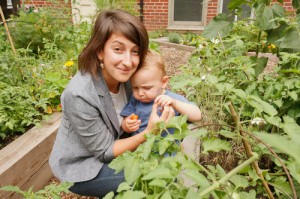
By Carolyn Purden
How can a church become a good neighbour? In the case of the Church of the Resurrection, Toronto, it has been as simple as starting a community garden.
The church has a large area of grass at the front of its property that for years was largely untended and unused. In the past, the congregation had thought of using it for parking, but nothing was done. For the neighbours, it was an eyesore.
Then, last summer, Miranda Snyder and some volunteers from the congregation started a small-scale vegetable garden on part of the land. As they worked, they found two things were happening. Neighbours and parents picking their children up from the church’s daycare were stopping to chat. And the gardeners themselves were casting longing eyes at the untended part of the property and imagining what they could do with it.
Based on the unexpected interaction with the neighbours, the church gardeners decided to turn the unused land into a large community garden that everyone in the neighbourhood could tend and enjoy.
There were several challenges, the major ones being finding a design for the expanded garden, raising funds for the necessary supplies and finding volunteers to do the work.
An architect in the congregation provided a design for the beds that was based on a monastic garden, with triangular beds in the centre surrounded by rectangular beds. A building team was assembled and local merchants donated goods such as lumber.
“We met with the gardeners from the community and the gardeners from the congregation and together we built it,” says Ms. Snyder. “It was a huge and involved building project, but it was really exciting to see everyone gathered together to create something really special in the community.”
The gardening team raised funds from members of the congregation, and they also applied for a diocesan Reach grant, receiving $2,000. “That really propelled us forward with this project,” says Ms. Snyder.

The search for volunteer gardeners was easier than she had expected. The church group talked to neighbours, to people in local parks and to members of the local gardening club. Within weeks, they not only had all the volunteers they needed, they had a waiting list. “The response was overwhelming,” says Ms. Snyder.
Everyone has their own plot or plots to tend. Each plot measures about 50 square feet, and the gardeners are free to plant whatever they choose. Most people have opted for vegetables and the produce is theirs to use.
While people garden as they have the time, Monday nights have become community gardening nights, when all the gardeners get together to tend the plots and water them. The Reach grant could not be spent on capital costs, says Ms. Snyder, so the money has been used for community barbeques, gardening pub nights, children’s activities, picnics and jam-making.
“The garden has been an amazing space where people in the community are able to gather in a variety of ways,” Ms. Snyder says. “Many people who have never been inside a church before feel really comfortable coming into a garden. We feel we’ve turned what was basically an unused and pretty derelict private space into a community asset.”
While the project is largely completed, there are still a few things that are needed. For example, the only storage area for tools and wheelbarrows is a hard-to-access crawl space, and winter storage space is also required. But Ms. Snyder feels confident that the funds will be easily raised before the next gardening season begins.
The garden has been a great success and Ms. Snyder sums up the feelings of the church gardeners. “We felt that there was a real need to go out and be good neighbours in our community, and we feel this garden has been an awesome entry point into the community to do just that.”